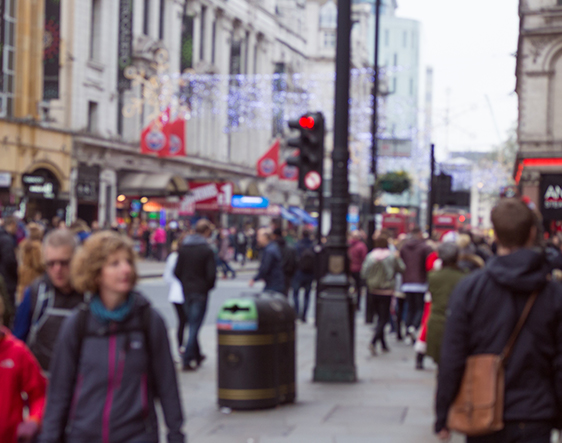The high street is the quintessential British shopping experience. Almost every town has one, making it the most common street name in the UK. It’s the centre of commercial life; a place where you can buy, sell, or trade almost anything. Contributor Jonnie Matthew, Founder – Solillas.
Yet, in the past ten years, high street shopping has been on the decline. It’s a perfect storm of a struggling economy and cheaper ecommerce options, leading to a 2.2% decline in high street footfall between 2008 and 2015, according to Springboard data.
It’s estimated that nearly half of all high street shops will close between 2020 and 2030, with ecommerce accounting for 40% of all UK retail sales, according to ParcelHero. The takeover of ecommerce may happen even quicker than predicted. According to ONS statistics, high street retail figures for December (usually the highest) have been declining for the past five years, yet online sales have been rapidly rising by around 20% each year.
With one in seven shops currently boarded up and 15 more closing every day, is the high street finally dead?
No – at least not all of it. Some sectors are not struggling. In fact, while many shops have closed their doors, the high street is growing for some outlets like coffee shops, takeaway food, and other leisure-related shops. Some have suggested that high street shops are undergoing a transition to become ‘experiences’ – with music, coffee, even work desks – in order to attract footfall.
I think some sectors will see a resurgence in popularity on the high street due to the tangible nature of products – much like the resurgence in vinyl in the wake of digital music. Fashion, in particular, will be an important sector for the high street, despite recent declines.
Here are four reasons why I believe the high street is not dead:
The high street helps small businesses break through
A fact that most people won’t know is that brands give retailers a marketing budget – whether they sell online or on the high street. Ecommerce sites, however, charge a lot more for their prime advertising positions, whereas in-store is a much more level playing field.
This means that new brands can gain more visibility for their products in-store than online, helping toward the essential first purchase. Without that visibility, new brands will struggle to break through into the mainstream as they will always have a smaller marketing budget than the big, established players.
Having the newest, most original products is especially important in sectors like fashion, where creating an original look is essential. If everyone shopped online for their clothes and footwear, they would end up buying the same products from the same brands, leading to a stagnation of fashion.
You can try it out on the high street
When a customer purchases from a new brand for the first time, they’ll need to know that the product is high quality and will meet their needs. They’ll want to see the range of colour and size options rather than relying on edited product shots.
This is particularly true for items like footwear. Not only is the fit important for aesthetics, but it will also impact how comfortable the footwear is to walk in and whether they’re right for your feet. Once the customer knows the footwear suits and fits them, they may well opt to buy online in the future. But in-store shopping is very important for that first purchase.
Some retailers, such as ASOS, are using free delivery and returns to get around the issue of trying before you buy, but most retailers don’t have the resources or capacity to match these generous delivery options just yet, making high street retail an essential step for most fashion purchases.
High street shops help build brand belief
Another reason brands won’t abandon the high street is the powerful effect associating with established retailers can have, especially for new start-ups. Brands can be treated with scepticism if they are unknown and untested. Online, the situation is even more challenging.
Often you don’t know whether the website you are purchasing from is even legitimate, you have few guarantees that the product will be as advertised, or that you will even receive the item if the delivery goes wrong. It’s much harder to pack-up shop and move to a different physical location, meaning high street shops have a greater investment in their brand. Because of this, high street shops come with a sense of trust that ecommerce sites struggle to replicate.
New or relatively unknown brands can benefit greatly from the association with a bigger, established, and trusted high street brand. Customers know that if they go to John Lewis, for example, the products on offer will have been tried and tested for quality by John Lewis buyers. The product isn’t likely to break or fall apart easily, and if it does, you can always take it back to the shop.
Brands get real-time feedback
Feedback is essential for most brands. Not only does it help you improve, it connects you with what your customers actually want. As a footwear brand, we find this feedback invaluable to our design process and wouldn’t have found the success we have without it. For example, we meet with retailer, Office, to find out what customers have been saying about our products on the shop floor. We often hear things like: “they would love it in this colour”, or “it would be perfect if it has a buckle”, and we integrate that feedback into our design process, creating new products in a matter of months.
Even fast fashion retailers online don’t get such quick feedback. Instead, many online retailers use analytics to gain broad insights into the upcoming trends, and by the time the analysis is complete, trends have moved on. Only on the high street can you access such rapid and in-depth feedback – making the high street essential for the development of new, exciting trends.









